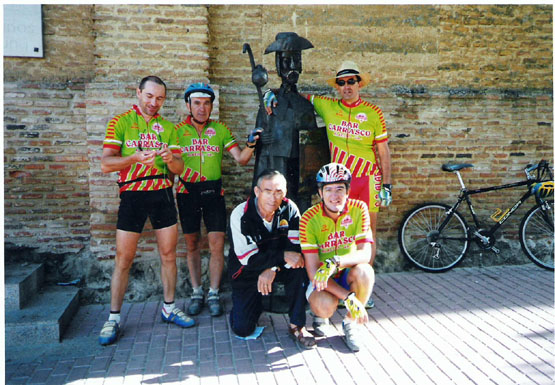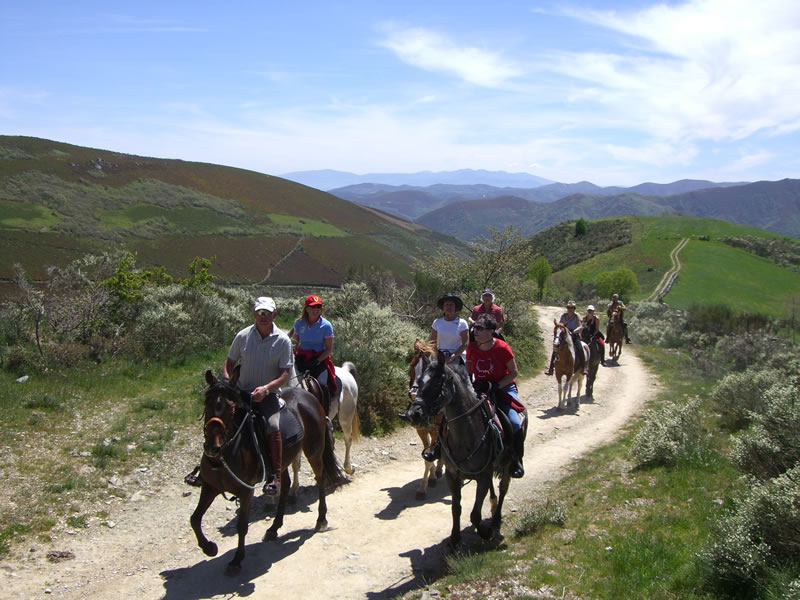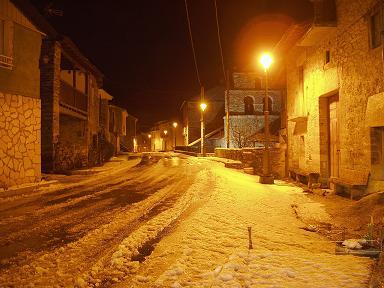How to make the road
1) WAYS TO MAKE THE WAY
WALKING
It is very normal for the person who thinks to do the Way, have their doubts if doing it alone or with company; The answer would be that doing so alone is the way of not having to depend on anyone to make any decision, that at no time will you find yourself alone, and that you will be able to enjoy in all its fullness of the Way and the inner quest to do so.
We understand that there is no danger as well, because the route is very defined and, except in very extreme winter times, it is almost certain that a few kilometers further pilgrim follows and if necessary, will assist.
However, in the Camino you will find the right company.

CYCLING
As opposed to walking, having to rely on a machine, which in its simplicity can pose mechanical problems, it may be convenient to go with company, and in case of need for breakdown, one of the group could move in search of what necessary.
On the other hand, the bicycle requires all our senses, for we not only have to think about ourselves, but also about it, so that we do not break ourselves.
We will have to be very present the traffic and, if we are a group, to walk very carefully and in line.
It is also convenient to wear tight cyclist clothes that do not have flights or offer as much resistance to the wind; To take care of the color, that they are alive tones, so that the motorists can see us with clarity.
They are more than 800 Kms., So we must forget about racing, and the one that walks the most, let the last one go, except when there is wind, so it is advisable to go first.
Be very careful not to carry any rain cover or similar concept, because in addition to the inconvenience that results, could be very dangerous.

BY HORSE
Unlike on foot and just as on a bike, it is convenient to carry out the Road in the company of other riders.
Previously it is advisable to have made the Camino by car to arrange the stables and overnight places of the animal, as well as to leave the feed enough for when it arrives.
It is imperative to carry the insured animal, as both the traffic traffic and the expectation that provoke the horses to the people in the populations are propitious occasions for any mishap; Let the horse not take advantage of some neglect of the rider to eat the best flower of the place or to enter in the middle of the cereal.
Pilgrimage on horseback has three phases, the third of which is to perform the Camino:
PREPARATORY (choice of horse, vet recognition, vaccination, transit from one feeding to another, hygiene, training or adaptation to new work, rider preparation, equipment and equipment).
TRANSFER (guide-documentation, food, medicine cabinet, addresses of veterinarians, vehicles, etc.).
EXECUTION, that is to say, to carry out the Way of Saint James (observe daily the health and hardware of the horse before the start, correct placement of the equipment, start the stage at a pace, observe and anticipate the terrain to travel at each stage, always accompanied , Pay attention to any problem or limp, finish the step to the step. Hydrotherapy of the animal, review of bumps, inflammations, rubbing, etc. and corresponding cures).

2) CHOOSING THE TIME
Assuming we can choose the time or month to do it, each one has its charm, but we bow in spring and autumn; Late April, May, June, September, are splendid months, with long days, without the rigors of the summer heat, and, more importantly, with very few pilgrims, since it should be noted that practically 75% It does it in the months of July and August, with what it supposes of massification, while our opinion is that in fact it is a way of search, solitude and silence. Very careful in winter, areas like in the cross of Iron and in O Cebreiro can have Snow and Ice. Look at these times that most hostels remain closed.

3) DISTRIBUTION OF THE STAGES
Of course, with the data provided by this guide, and knowing your possibilities, before leaving, you will have predicted which are the stages to realize.
Before going any further, a tip: I LOOK FORWARD TO MAKE THE WHOLE WHOLE ROAD ON A SINGLE SHOT, and I say this, because it is now becoming fashionable to do short weekends, bridges, and so on, to take a few kilometers away. Later, and now from a pull, from Leon, Ponferrada or other places already relatively close, to arrive at Santiago.
Another current fashion is to realize the Road with the whole family or good part, which is also inadvisable. Firstly because a very closed group is formed, and the Way is the opposite, the experience of the pilgrimage is totally open to the exterior and to the interior. And second, because the injury or illness of one of the members would truncate the Road to the rest of the family.
Of course, we have nothing against it, but that is not the way to fully enjoy the Camino de Santiago.
Once this section is done, let us return to the theme of the stages, which do not have to be immovable with respect to what we had foreseen. Any event, and this may be the stay with a pastor or a peasant chatting, can force you to redo the stages.
We would almost say that the clock should leave it at home, and therefore also the haste; Having the "obligation" to reach a certain point, is often a cause of many dropouts.
Improvisation should not exist before beginning the Path, but once in it, it is even more exciting.
The stages, of course, we will have to predict them depending on the shelters, and with the certainty that we will not lack, if we need, a floor and a roof, but neither is it a tragedy to sleep under the stars ...
4) WALKING TECHNIQUES
If we have a habit, the comments are not enough, but for those who do not have it, we advise that it is advisable, of course depending on many factors (age, body weight, backpack, etc.) to start smoothly, never in a hurry, until the Body gets hot. When accelerating, with regular and continuous running, where possible, with smooth and rhythmic passage.
It is also advisable to start before walking, to perform some stretches, especially of the legs, placing them with the hands against the wall, and to support gradually the whole soles of the feet, until there is a certain tension behind the knees, as The body is approaching the ground.
It is very possible that the Camino itself forces us to make frequent stops, to see some monument or church, to ask any question, to take a photo, etc., but, in principle, we should rest at least ten minutes every hour or two hours, Or more if necessary. However, the same body, the weather or any other circumstance, will indicate or request.
While walking, we always have to keep a comfortable step, which allows us without any effort to have a conversation. Walking has to become as natural as breathing, that we do it without realizing it.
On level ground, let us go with our normal step, neither too long nor too short; On the climbs, since we are not in a hurry, with shorter and slower, perhaps loosening the belt of the backpack to be able to breathe better, and supporting the foot with the whole plant on the ground, to avoid overloading certain areas.
In the descents and whenever the floor allows us, with a long and fast step, nailing the heels well and maybe squeezing the backpack a little more to the waist to rest our shoulders.
We end up giving a million steps, but we do not have to neglect any and see where we put the foot; A single wrong step can force us to withdraw; Therefore, especially when we go through rough terrain, loose stone or pebble, we must be careful when treading.
Of course, if we go with someone who has the fastest pace, we should not try to keep pace, because in just a few hours, we can leave shattered; It will be convenient, therefore, that the one who walks, put the last one and do not set the pace.
It is advisable to assist in both the ascent and the descent with the staff, which also makes the floor less monotonous.
5) CLIMATOLOGY
In the section "Choosing the time to do it", we have already given a slight guideline of what is the best time of the year to launch the Path, spring and autumn, because the temperatures are mild.
The maps that accompany this Virtual Guide carry a diagram that marks the rainfall and average temperature of the area represented in each map, which serves as a reference index to get an approximate idea of the climate that can be found along the Camino de Santiago . Moreover, if we know the similar data of our city of residence, we can make our personal comparison and know if where we are going to rain more or less than where we are, if it will do more or less heat, cold, etc. And consequently if we have to carry more or less clothes, etc. Of course, this rule can serve us automatically as long as we do not change the tropics; In that case, we must be aware that when in Spain it is summer in Australia it is winter, and vice versa.
In order to avoid this error, in addition to the diagram that illustrates each map, we next relate the temperature and rainfall of the warmest and least rainy month (summer), and the coldest and rainiest month (winter), of each region of the Camino de Santiago in Spain. We started in Galicia and finished in Navarre and Aragon, and in the Pyrenees.
6) PREVIOUS TRAINING
WALKING
We have already made the decision and, therefore, we have to start quickly with the training; To the Path, as far as possible, we have to go to enjoy how much it has, we have to concentrate on it and its philosophy, which has it, and very rich indeed, and forget about fatigue, blisters and feet.
If we are not very accustomed to walking, at first we must start with short walks, which will be progressively extended, especially on weekends, if possible with exits to the mountain, to get used to the ups and downs, until we get to dominate the Distance that we believe will be that of the stages to be realized.
The last exits we should carry out with the backpack loaded to make us to his weight, and at the same time we can serve to realize if the weight we carry is excessive, because it is very different to do a Sunday 25, 30 or 35 km. Home, shower, sleep in our bed and the next day continue with normal life. It would be convenient in the last weekends, to try to walk with the backpack on Friday afternoon and make the maximum of Km., Saturday the same, and again on Sunday with the equivalent in Km. Of the planned stages; If we do it without great problems, arriving in Santiago will only be a matter of days.
It is necessary to take into account that the authentic training we will realize in the own Way, and we will be easier to do 40 km in the last third of the route, that 25 in the first one.
However, for those who have not had the possibility to train before beginning, indicate to them that the best training is the very realization of the Path, but that in their case, they should start very smoothly and gradually increase distances, In the certainty that the body itself will warn us if we are acting correctly.
CYCLING
We think that for people who do not have much habit, and depending on the distance to travel each day, with two months will be enough. We should start slowly, at first rolling, to later alternate the flat parts with rises; In this way we will become accustomed to know the multiplications most suitable for each profile.
If it were possible, it would be very interesting, especially at the beginning of the training, to be accompanied by a person in the habit of riding a bicycle, to teach us his "secrets."
Like everything in this life, it is a matter of proposing it, taking it seriously.
I can not resist commenting on the case of a lady, who, without knowing how to ride a bicycle, arrived in Santiago ... and still could not walk. Very simple: Her husband, due to some rehabilitation problem, had to bike every day. With a small, folding bicycle, he made it himself with a few tubes, a tandem type, and his wife, so he would not be bored, accompanied him in the back seat every day, but he did not know how to ride a bicycle. I do not know who he came up with, but the case is that accompanied by his son about 16 years, he, of course, guiding, made the Camino de Santiago in 1991.
The bike had no changes, so many slopes had to push them up. To lower them, was another problem, because the brakes did not respond to being loaded with the luggage, and they also had to get off the bike. The stages they performed were, in distance, equal to those of those who were walking, but they arrived in Santiago happily ... and did not finish learning to ride a bike.
I think that as to what can be done, everything is said.
Another thing would be the stages or days used in making the Way; Do not go in haste, take the necessary time.
It would be very convenient to train the last days with loaded saddlebags; In this way, in addition to getting used to it, we would realize that the weight and volume of the luggage is a problem, so it is best to reduce them to the maximum, taking, therefore, the really essential.
7) BEFORE STARTING ...
It is convenient that you read carefully the guide that you have, and you will be informed of everything that you can see in the planned stage, even taking into account possible modifications.
Keep in mind, if you plan to go out before dawn, that in the morning will not be seen, and probably not meet someone who can inform you, so it is interesting to know perfectly the way forward.
If you do this, you will take better advantage of your time and you will not lose anything that you consider interesting.
Make sure you have a bar or a store where you can eat or buy food, if there are fountains or you need to fill the canteen, if you need to go to a bank or a box, etc.
Try improvising on what is really worthwhile, but do not have to regret it for not having read what was the most interesting thing you could do or see that day.




